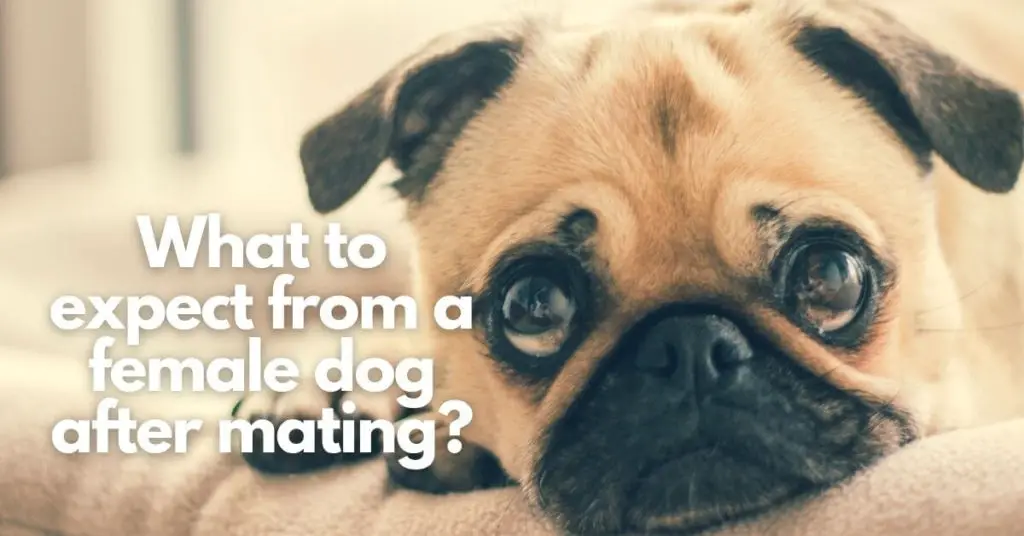Is this your first time mating your female dog? Do you want to know what you can expect from a female dog after mating? If yes, you’re at the right place!
In this article, you’ll find out:
- What to expect from a female dog after mating?
- Why do female dogs cry after mating?
- How long after mating can you tell a dog is pregnant?
- And a lot more…

What To Expect From A Female Dog After Mating?
One of the first things that you can expect after mating is a lot of moisture on a female dog. Your female dog may also become aggressive to other males. If it was your dog’s first time, she might be a little uncomfortable afterward. If she continues to walk awkwardly, you should take her to the veterinarian.
9 Changes In A Female Dog After Mating:
1. Damp Hair & Fur
You can expect a lot of dampness on the female dog after mating. That’s because she was wooed, which means the male dog licked her to get her excited.
During mating, the saliva of the male dog may also drip on the female. As a result, you may expect to find saliva on the hair on her head and down her back.
2. Behavior Change
Female dogs, unlike male dogs, do not roll around on the ground after mating, and they do something completely different. Following mating, female dogs may become suspicious of males and keep their distance.
They could also appear tired and sleep more than normal. Another sign identified in the female is a notable change in their walking style, which could be due to mating discomfort.
This normally goes away within a day, but you should consult a veterinarian if the female dog is still walking weirdly after a day.
3. Mating Odor
Another thing which you can expect from your female dog after mating is a strong odor surrounding her vulva that’s unique from her heat cycle. It could be strong enough to be felt in the near vicinity, or it could only be felt when you are close to your dog.
4. Tiredness
You can expect some changes to be visible right after mating, while others will take a while to appear. The female dog becoming sluggish and sleepy more than usual is a symptom that appears after a while. You must allow her to sleep peacefully in this situation.
5. Change In Walking Style
Another sign you can expect after mating in the female is a notable change in their walking style. It could be due to mating discomfort.
This normally goes away within a day, but if the female dog is still walking weirdly after a day, this might be the indication of any serious injury. If the issue persists and your dog appears distressed, seek advice from your veterinarian.
6. Licking Her Genitals
Your canines will lick their genitals after mating to clean the area like they do the rest of their body.
Hence you can expect a female dog to lick her vulva after a sexual act to clean herself.
According to Dr. Ryan Llera, BSc, DVM of the VCA Hospital, if your dog licks more than he should and you observe the following syptoms, consult your veterinarian since it could be an infection or an allergy:
- swollen or red penis, vulva, or anus
- presence of pustules (pimples) or red bumps on the skin
- discoloration of the skin (black or rust colored)
- straining to urinate
- increased frequency of urination
- scooting or rubbing the rectal area on the ground
- presence of a foul odor between eliminations
- discharge from penis or vulva
7. Period Bleeding
A female dog will most likely continue period bleeding till the heat cycle is over.
For dogs, bleeding is the start, not the end, of their reproductive stage, so if she mates within the first nine days and bleeds gently afterward, it does not necessarily indicate a problem.
Hence, it is not unusual for a dog to bleed after mating, and the blood should be thinner, more watery, and lighter in color by this time.
8. Loss Of Appetite
If your dog gets pregnant, she may experience a temporary loss of appetite at the beginning of her pregnancy. This is similar to the morning sickness humans experience and is entirely normal, so don’t be worried. Simply keep her hydrated by providing her with plenty of freshwaters.
9. Pregnancy
Within the first week or two following the mating, if there is a change in the dog’s mood and behavior, restlessness, vomiting, clear vaginal discharge, or they show less interest in eating, contact your veterinarian. There’s a high chance that the female dog is now pregnant.
Why Do Female Dogs Cry During Or After Mating?
If you notice the female dog or bitch crying or whimpering a lot, this could indicate that she is disturbed by the process. Try to calm her down because your female dog’s barking, howling, or other distress behaviors can truly traumatize a male dog and it may injure them both even more and prevent a successful coitus session.
What Are Some Female Dog Injuries After Mating?
It’s frightening to see your female dog get injured during the mating process, whether mild or serious.
Due to the following reasons, there is a considerable chance that your dog will get injured during mating.
1. Stud Suddenly Pulls Out During Tie
Your dogs are at risk of hurting themselves and each other at any time after they are tied.
If the stud sees anything he wants to chase, he may rip his penis loose, causing your bitch to bleed. The male dog may suddenly pull out during the tie and harm the female dog’s vagina.
2. Stud Hurting The Female Dog During Mating
During the mating session, the male dog may decide he’s had enough and snaps at the female dog, hurting her badly enough to result in major injuries. It can sometimes be so severe that they become celibate and unable to reproduce.
3. Female Dog Is Uncomfortable During Mating
There is a possibility that the female dog is not comfortable to mate and does not want to proceed with the mating process or the tie. This could happen especially if it is her first time mating. She could be crying or making howling sounds during mating and attempts to extract itself from the mating process.
At this point, the stud may grow aggressive and exert its dominance by physically hurting the bitch. This could end up with physical injuries as well as negative emotions to your female dog.
Hence, if one or both dogs become aggressive during the copulatory knot, they may pull apart, causing internal harm. Therefore, make sure one or more people are present to keep the dogs quiet.
These injuries can be prevented if you keep a close eye on the pair throughout the procedure. Due to this reason, many professional dog breeders keep the two animals on their laps while they are tied together.
While this may seem unusual to do during this “emotional” time for your pets, they rely on their humans for assistance regardless of why or when. To avoid stress and injuries, ensure that both dogs remain calm at all times.
Can I Bathe My Dog After Mating?
Yes, you can give a bath to your dog after mating, but you need to consider a few things:
1. Avoid Any Flea or Medicated Shampoos
You should avoid any flea rinse or medicated shampoos and always use a dog shampoo that is appropriate for your dog. Otherwise, their skin may become irritated. When a dog is in heat, its vagina is already sensitive; therefore, it’s not a good idea to use anything that could irritate it even more.
2. Be Gentle When Bathing
Make sure you don’t stimulate their genital area with your hands when bathing them. You must also be careful when drying them with towels or a hairdryer.
3. Use Lukewarm Water
Make sure you’re using water that’s at least lukewarm. Anything that is too hot or too cold can create health problems.
4. Create A Relaxed Environment
Provide a peaceful environment and be gentle at all times to ensure the dog is relaxed.
However, if your dog dislikes baths, the situation can become extremely stressful. Obviously, stressing out a dog is bad for them; hence, for the time being, use a wet cloth to gently wipe your dog down.
If your dog becomes agitated while bathing, wait a few days or give her a dry bath with finely powdered oatmeal and thorough brushing.
Why Is My Female Dog Not Eating After Mating?
During pregnancy, your dog will go through a lot of changes, including changes in her nutritional needs, behavior, and eating habits.
2 to 3 weeks after mating, a female who becomes pregnant may experience a loss of appetite for 3 to 10 days. Many dogs go off their meals for a while to adjust to changes in their hormone levels.
This is a typical occurrence that isn’t too concerning as long as the dog is eating something. The good news is that your dog should be starting to feel better and eating normally again soon, and she may even feel a rise in her appetite to compensate for the lost time.
Go ahead and feed her her favorite meals till she turns the corner. To make things healthier, alternate between boiled chicken and brown rice and ground beef and cooked carrots in her meals.
However, a loss of appetite that lasts longer than 1-2 days could indicate a medical problem that should not be ignored. Consult your veterinarian if she goes without eating for more than 1 to 2 days.
How Long After Mating Can You Tell A Dog Is Pregnant?
Your veterinarian can perform an ultrasound scan as soon as 3 weeks after mating to discover if your dog is pregnant.
What Are The First Signs Of Pregnancy In A Dog?
There are very few external signs of the dog’s pregnancy in the first few weeks, so you may not notice a difference, and it might be difficult to know if your dog is pregnant, but there are a few obvious signs.
If you’re wondering if your dog is pregnant, look for the following five symptoms.
1. Morning Sickness/ Loss of Appetite
Canine pregnancy symptoms normally appear in the second trimester, about three weeks after conception. Some dogs experience nausea and vomiting, commonly known as morning sickness, as a result of hormonal changes in the third or fourth week, but only for a few days.
It’s possible that your pet will appear tired and eat less than usual. They lose their appetite and become nauseated from time to time. The majority of dogs will not go longer than two days without eating. If she refuses to eat for three days in a row, you should consult your veterinarian.
Your dog, like a pregnant woman, may also vomit a little in the early stages of pregnancy. Consult your veterinarian if the vomiting persists or if you have any other concerns.
2. Lethargic/Tired
A sudden decrease in your female’s activity level could be another sign she’s pregnant. This sudden slowdown is due to hormonal changes. The female dog may appear to be lethargic and rest for long periods of time.
This normally begins around two weeks into the pregnancy and disappears after a few weeks as she adjusts to her changing circumstances.
3. Nipple Swelling
Swollen nipples indicate that your dog’s body is changing as a result of pregnancy.
An unbred female’s nipples are typically small and flat. When a pregnancy is in progress, the milk glands beneath the nipples begin to expand, and their nipples will darken and grow in size as well.
As your pet’s due date approaches, their breasts will expand, and a small amount of milky fluid may trickle out.
4. Larger Abdomen
By the middle to late stages of pregnancy, it is common for pregnant female dogs to have belly enlargement. Your dog’s abdomen begins to grow around the sixth week.
The majority of dog owners are aware of when their female dog has been bred and anticipate belly enlargement.
Even if her abdomen does not appear to be large, she could still be pregnant. You can take her to the vet for x-rays or an ultrasound to see whether any puppies are there if you want to be sure about the pregnancy.
5. Slight increase in weight
Dog’s may acquire a little weight in the first few weeks of pregnancy, but not enough to dramatically increase abdominal size. Her weight, as well as the size of her abdomen, will begin to expand about five weeks.
An expecting dog mustn’t gain too much weight, as this can disrupt delivery. Consult your veterinarian for advice on the healthiest nutrition for your expecting dog
It takes a keen eye to detect pregnancy in its early stages, but the signs become more and more visible as the weeks go.
Regardless of whether the breeding was intentional or not, it’s a good idea to take your dog to the vet for a prenatal exam to be sure her symptoms aren’t caused by an illness rather than a pregnancy.

